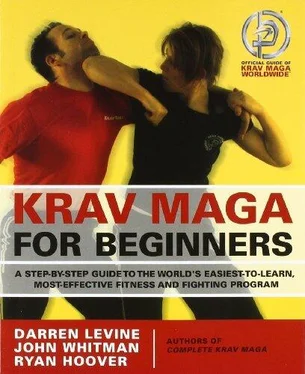INITIAL COUNTERATTACK→ Straight Punch (page 71) or Front Kick to the Groin (page 92). A simple counterattack is to deliver a right straight punch as you put your foot back down after defending. Another alternative is to defend the round kick, touch your defending foot to the ground, and immediately spring up with a front kick to the attacker’s groin, which will be open if he hasn’t recovered quickly from his round kick.
NEUTRALIZING THE ATTACKER→ After the initial counterstrike, the defender should continue to strike to the body and face. Students must focus on rendering the attacker unwilling or unable to continue the assault.
KEY POINTS
• raise your knee and point it at the oncoming kick
• your lower leg should act as a shock absorber
• defend with a strong part of your defense (the thick part of the shin bone) against a weak part of the attack (the attacker’s ankle)
COMMONLY ASKED QUESTIONS
When I defend, I just feel like I’m getting kicked in the shin. What’s wrong?
You’re making the defense too rigid. Don’t build a wall—raise a shock absorber. As the kick strikes your shin, give a little so that the impact is minimized. Note: DON’T give too much, or the kick will sweep right through your defense.
In a real fight, won’t this just hurt my shin?
It might. This is why we teach another defense (Absorbing with Thigh, described on page 123). Mixed martial arts and Muay Thai fighters use this defense all the time, but many of them condition their shins to take this punishment and minimize the pain. You probably have no plans to do that! However, keep in mind that in a real fight, which usually lasts only a short time, you may only have to deal with one of these kicks. Defend it with the strong part of your shin against his ankle, “give” a little with your shin, and you should be OK.
Defense against Low Round Kick (Absorbing with Thigh)
ATTACK→ The attacker throws a right round kick to the leg (knee or thigh).
IMMEDIATE DANGER→ Knee damage, temporary dysfunction of the leg. A round kick can hit the side of the knee, disabling it, or it can hit the side of the thigh, striking nerves in such a way as to temporarily disable the leg.
SECONDARY DANGERS→ Balance. Even if no serious damage is done, a strong low kick can shake the defender’s foundation, upsetting balance and putting him at a disadvantage.
SOLUTION→ Absorbing with Thigh
1As the attack comes around to the leg, bend your left knee and point it at the kick, flexing your quadriceps. Absorb the kick across the front of your quads; do NOT try to absorb the kick on the side of your leg. If your reaction is early enough, lean slightly forward to absorb the kick before it reaches maximum power.

Note: Keep your hands up! The kick may come higher than you expected. For defenses against high round kicks, please see Complete Krav Maga .
INITIAL COUNTERATTACK Straight Punch (page 71). A simple counterattack is to deliver a right straight punch. Unlike the counterattack for the Shin Block (page 121), which happens slightly after the defense, this counterattack can be delivered simultaneously with the absorbing defense. It’s a very effective, and sometimes devastating, defense/counterattack combination against a round kick.
NEUTRALIZING THE ATTACKERAfter the initial counterstrike, the defender should continue to strike to the body and face. Students must focus on rendering the attacker unwilling or unable to continue the assault.
KEY POINTS
• point your knee and the top of your quadriceps at the oncoming kick while flexing your quads. Make sure your knee is bent
• absorb the kick on the front of your quads, NOT the side of the leg
COMMONLY ASKED QUESTIONS
This really hurts! What am I doing wrong?
Possibly nothing. This is an absorbing defense. You are, in fact, taking the kick, but you’re just trying to do it in a way that limits damage and disburses the force. However, it’s possible that you can reduce the impact by leaning in and catching the kick before it reaches full power. Also, be sure that you are absorbing the kick on the front of your quads, not the side. Absorbing the kick on the side of your leg, where a sensitive nerve can be struck, causes a great deal of pain.
I was told that I can build up the muscle if I keep practicing this absorbing technique. Is that true?
You should definitely practice this absorbing technique, but it won’t build your muscles. Muscles do not get stronger when you hit them repeatedly. Practicing will help by improving your ability to flex the quadriceps, and to time the moment of flexion as you absorb. Plus, you get used to the pain, and it therefore seems to diminish.
Hand Defense against Groin Kick (Reflexive)
ATTACK→ The attacker throws a rising right kick to the groin when you’re totally unprepared and in a neutral stance.
IMMEDIATE DANGER→ Being struck (rather painfully!). The primary danger is being hit.
SECONDARY DANGERS→ Disorientation, balance. Groin kicks are not always as bad as they appear in the movies, but they can cause a) pain that temporarily disables you and b) an instinctive reaction to put your hands down, scoot your hips back, and pinch your knees in to protect your groin, which can compromise your balance, leaving you open to additional strikes.
SOLUTION→ Reflexive Defense against Front Kick
1As the attack rises, bend at the waist and reach down to sweep your left arm diagonally forward and across the line of your groin. Simultaneously bring your right hand up and across your face so that it can defend either a right or left punch. The defending arm should be straight (like a 2x4) from fingertips to shoulder; do NOT bend your wrist, although you can keep a slight bend in your elbow to avoid hyperextension. You can use any part of your arm to defend, but the higher up your arm the kick rises, the closer it comes to your body. The sweeping hand should redirect the kick away from your body. Make a body defense by blading your body, with the defending-side shoulder and hip moving forward.


INITIAL COUNTERATTACK→ Straight Punch. As you make the defense, burst in and trap the attacker’s arm with the non-defending hand (for most people, this will be their right hand). Switch hands so that your left is trapping the attacker’s arm, and counterattack with your right. Alternately, you can use your right hand to trap the attacker’s arm and counterattack with your left hand. This is faster, but usually less powerful.

NEUTRALIZING THE ATTACKER→ After the initial counterstrike, the defender should continue to strike to the body and face. Students must focus on rendering the attacker unwilling or unable to continue the assault.
Читать дальше
















